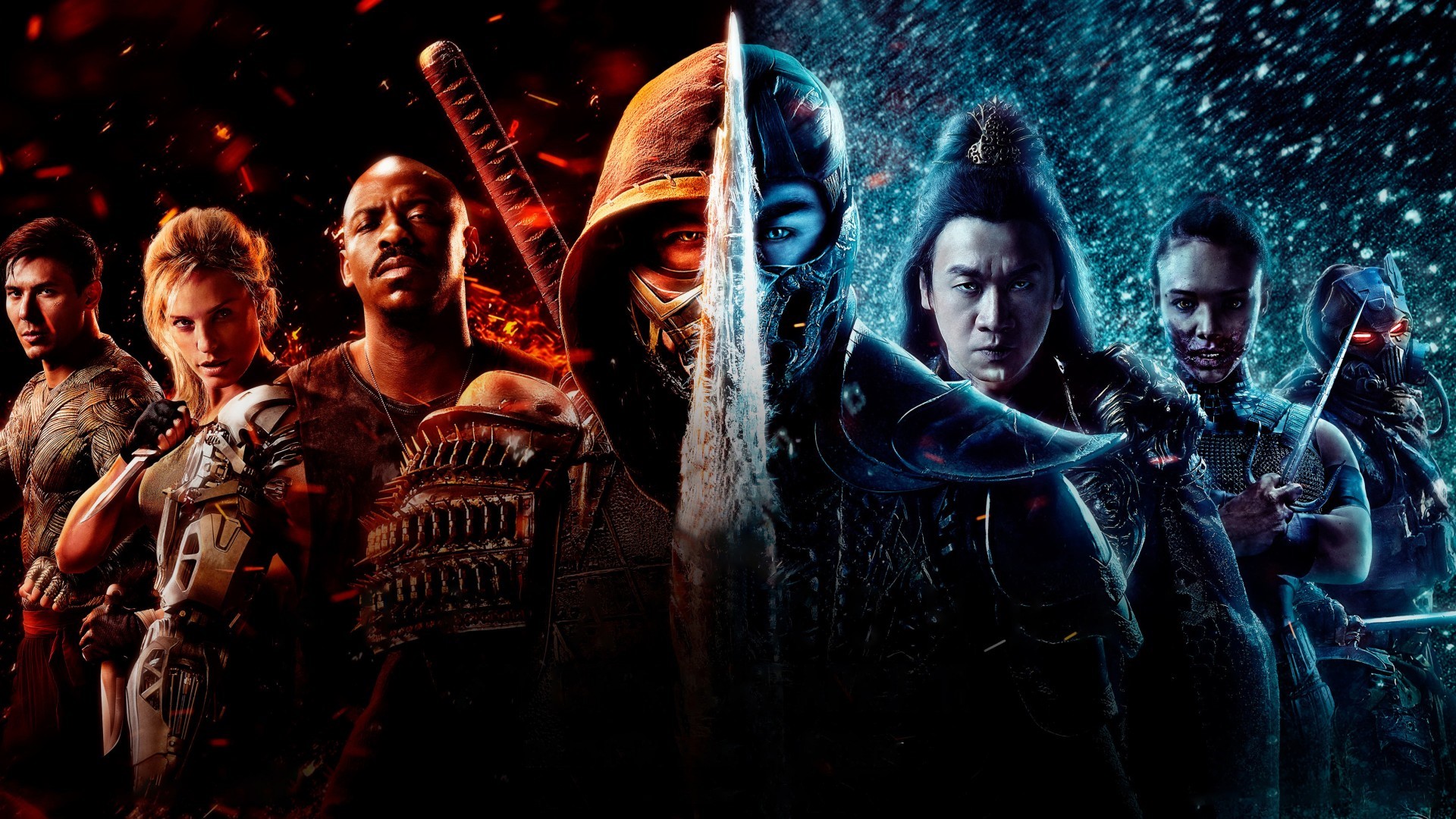April 30, 2021 — It has been almost 30 years since Mortal Kombat first worked its way into fans’ hearts — mostly by tearing them still beating out of their chests. Mortal Kombat remains one of gaming’s most beloved beat-em-up franchises and it is surprising it has taken almost 24 years for the series to return to the silver screen.
1997’s Mortal Kombat: Annihilation may have left a bad taste in most viewer’s mouths (horrible CGI, acting, and lack of half-decent set pieces only being a few of its lesser sins), but the original 1995 Mortal Kombat stands as a cheesy and nonetheless beloved cult film. With that in mind, we reviewed the newest attempt to adapt the seminal fighting series for the big screen to see if it, for once, attempts to break Hollywood’s tendency towards horrible movies based on great video games.
Choose Your Fighter
As with most fighting game franchises, Mortal Kombat has more than its fair share of colorful characters to choose from when it came to casting the new movie. By and large, the new movie plays it fairly straight with the core cast of the original video game. Of the original playable fighters, only Johnny Cage does not make it into the new movie (though his presence is heavily alluded to).

Instead, the core roster of Sonya Blade (Jessica McNamee), Kano (Josh Lawson), Liu Kang (Ludi Lin), Sub-Zero (Joe Talsim), Scorpion (Hiroyuki Sandara), and Lord Raiden (Tadanobu Asano) make up the principal cast, a selection of warriors fighting for the good (or ill) of Earthrealm alongside original character Cole Young and additional fighters Jax (Mehcad Brooks) and Kung Lao (Max Huang) ported over from Midway’s legendary 1993 arcade machine Mortal Kombat II. This motley crew of fighters faces off against the hellish forces of Outworld, each with their own nemesis in the form of Reptile, Mileena (Sisi Stranger), Kabal (Damon Herriman), Reiko (Nathan Jones), Nitara (Mel Jarnson), and Goro (Angus Sampson) all led by series mainstay Shang Tsung (Chin Han).
Stacking the decks almost equally between heroes and villains keeps things fairly easy to track so far as the trajectory of the movie goes. This also helps to avoid the pitfall of faceless villains that often creep into ensemble casts — though admittedly Reiko does feel an oddly beige choice. Most fighters getting their moment to shine in some stunning (and satisfyingly bloody) set pieces.
Fatality
The movie’s R-rating promised plenty of bloodsheds, and as always, the series’ iconic fatalities are a most welcome inclusion. They aren’t the only moves carried over, however — a number of iconic techniques also pop up in the form of ‘arcana’, in-universe explanations for attacks like Liu Kang’s fireballs, Kano’s eye-lasers, and just about everything Sub-Zero can do. Many other effects-heavy movies come off as cheap when brought to the big screen, but Mortal Kombat plays things just straight enough (and with a high enough budget) to ensure the movie’s effects have a sense of tangible magic to them. Looking at the credits, no less than eight visual effects studios were involved in Mortal Kombat’s creation, including Australia’s Rising Sun Pictures, California’s Mr. X, and US prime VFX-wizards known as Method Studios.
“While not perfect, the newest entry in the Mortal Kombat pantheon is enormously fun and satisfying to watch.”
Whether it be Kano ripping the still-beating heart out of an enemy, Sub-Zero fashioning ice daggers from spurts of blood, or Liu Kang summoning a flaming dragon (perhaps an allusion to both his animality and the infamous computer-generated dragon of Mortal Kombat: Annihilation), there are set pieces in this film that are designed to delight fans. In fact, the film is absolutely packed with Easter eggs that point to wider lore, small pieces like the amulet of fallen Elder God Shinnok serving a similar purpose to the Infinity Gauntlet tease in early Marvel Cinematic Universe (MCU) movies.
Mythology
The series’ core concept of a fighting tournament to decide the fate of the realm is kept largely intact for the movie, albeit with a slight twist. The film instead follows the machinations of Shang Tsung as he tries to manipulate the titular tournament to avoid a prophecy that suggests Earthrealm will ultimately prevail by killing the fighters before they can ever step into the ring.

By not focusing purely on the tournament itself, we are given time to adjust to the characters and learn the lore as it develops steadily. This also makes the intrusions by Outworld warriors like Sub-Zero seem even more dramatic by comparison; one of the film’s early highlights is a cat-and-mouse chase by Sub-Zero that shows how well the magic of the series can lend itself to a thriller setting. As a merciless, magical killing machine Sub-Zero makes the perfect core villain, and seeing him rain ice blocks onto a screaming public shows how out of their depth the characters are at first.
“Equally, the introductory sequence that sees the future Sub Zero and Scorpion go head-to-head sets the scene for the movie’s era-spanning mythology.”
Equally, the introductory sequence that sees the future Sub Zero and Scorpion go head-to-head sets the scene for the movie’s era-spanning mythology. Tying these threads together turns into a more difficult prospect, however, as the film’s pace dips in points and story-parts feels slightly tacked on as it tries to bring things back in satisfyingly for the final battle. Equally, even with newcomer Cole’s tenuous links to fan-favorite Scorpion, being robbed of a true mano-a-mano in one of video games’ most iconic rivalries feel cheap. The final fight also rings all-the-more hollow knowing that the film sets up Shang Tsung as the big boss only to sequel-bait at the last second and have him literally walk away with the promise of a return and (presumed) resurrections for every fan-favorite killed during Mortal Kombat 2021’s run.
Verdict
7
Out of 10
The Good
- Set pieces really are spectacular, a work of art cementing the magic of the world while avoiding looking cheap.
- The fight choreography is solid which makes the martial arts backdrop feel grounded — the choreography is an important part of martial arts and action movies, but is often overlooked in favor of visual effects.
- The gore is satisfyingly visceral — the combined one-two of Kung Lao using his razor-hat to bisect Nitara and then having his soul devoured by Shang Tsung is a slamdunk highlight of any Mortal Kombat adaption.
Additional thoughts
- The dialogue veers towards cheesiness. Whenever a character refers to themselves in the third person, it is time for a rewrite.
- The obvious sequel-bait means the film does not end in a satisfying way
Finish Him! (Conclusive Thoughts)
While not perfect, the newest entry in the Mortal Kombat pantheon is enormously fun and satisfying to watch. Not as campy as the original film adaption, it has its own sense of magic and mysticism that helps it build an effective cinematic universe. Even if it does not get a direct sequel, the film has enough memorable moments to keep fans’ appetites satiated for a few years — at least.
Produced by New Line Cinema, Mortal Kombat is the latest Warner Bros. distributed film to launch on streaming service HBO Max the same day the movie premiered in theaters. Mortal Kombat debuted on April 23 on HBO Max and will remain available to stream until May 24. We expect other streaming services to begin offering the film this summer or early autumn. Meanwhile, we recommend watching the R-rated trailer below.





































